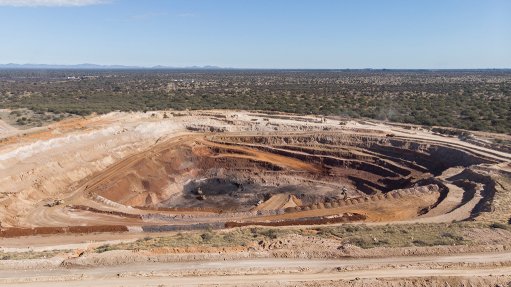
OPENPIT Manganese is extracted from three layers and blended to a grade of 36.5% manganese.
Manganese demand globally is likely to grow exponentially, as it is considered a key input in renewable technologies.
This potential demand presents opportunities to build new mega-mines, attract foreign direct investment and create new job opportunities in the local mining sector, avers Menar MD Vuslat Bayoglu.
According to available information, there are 23 manganese mines in South Africa, which are located in the Northern Cape and North West provinces.
“More than 80% of the world’s manganese reserves are found in the Kalahari basin of South Africa,” says Bayoglu.
Last year, local manganese production increased by 18.3%, to 19.2-million tonnes – exports increased by 4.9%, to 16-million tonnes, and local sales volumes by 14.4%, to 2.5-million tonnes, compared with the same statistics published by Statistics South Africa in 2020.
However, Bayoglu states that all sales earnings indicators declined, with export earnings decreasing by 0.4%, to R34.3-billion, and local sales by 3.1%, to R2.8-billion.
Meanwhile, total employment in the manganese industry last year increased by almost 9%, to 13 290, compared with 2020, while total labour earnings were up by 17.3% to R5.2-billion.
Bayoglu notes that countries in Europe and Africa are rebuilding their economies while pursuing the implementation of a renewable-energy transition.
Infrastructure construction – a key pillar for governments looking to reignite their economies – requires a robust manganese mining environment to help to achieve infrastructure development targets, given the metal’s importance in glass and steel manufacturing processes.
Solar and wind farms, which are key drivers of decarbonisation, require large amounts of steel during the construction phase, he adds.
“There are endless upside possibilities for South Africa to benefit from its endowed manganese wealth,” he says. “That is why we are actively looking for new investment opportunities in manganese and we hope our exploration efforts will yield positive results.”
Bayoglu notes that, as South Africa transitions to an economy reliant on ‘clean energy’, battery metals will become more prominent.
He cites a Mining.com research report, published in 2021, which states that nickel-metal hydride electric-vehicle batteries, predominantly used in hybrid vehicles, and lithium-ion batteries will be major catalysts for future manganese demand.
Bayoglu also cites market research company Industry Research Biz which projects the global manganese market to grow significantly by 2028.
Owing to the Covid-19 pandemic, the global manganese market was estimated at $25.2-billion in 2022 and is forecast to reach $29.8-billion by 2028, with a compound annual growth rate of 2.8% between 2022 and 2028.
He agrees that the market is growing at a steady rate and is likely to continue to grow.
East Manganese Mine
The commissioning of the East Manganese mine, in Hotazel, in the Northern Cape, marked a new chapter for the Menar group and the country, says Bayoglu.
East Manganese mined its first ore in September last year, and ramped up production to 30 000 t a month of run-of-mine ore in December.
“East Manganese is an opencast mining operation with a 900 000 t reserve,” he says.
South African exploration and mining company Sitatunga Resources – in which Menar is the major shareholder – acquired East Manganese in 2018 from prospecting and mining company Sehunelo Group subsidiary Southern Ambition.
Sitatunga has established a grade-control section, which employs a grade-control geologist and a supporting team, and a fully equipped on-site laboratory to oversee the blending process.
Bayoglu says all mine infrastructure has been developed, including the 350 t/h dry crushing and screening plant. “East Manganese has helped us through the manganese learning curve and we are ready for a much bigger project now.”
Further, he stresses the importance of diversifying assets and mining a variety of minerals, as a diversified portfolio also mitigates risk because commodity prices tend to be cyclical.
“It is important that we produce a variety of minerals to meet demand spurred by global trends in energy generation, construction, manufacturing and the ever-present need for food security,” Bayoglu concludes.